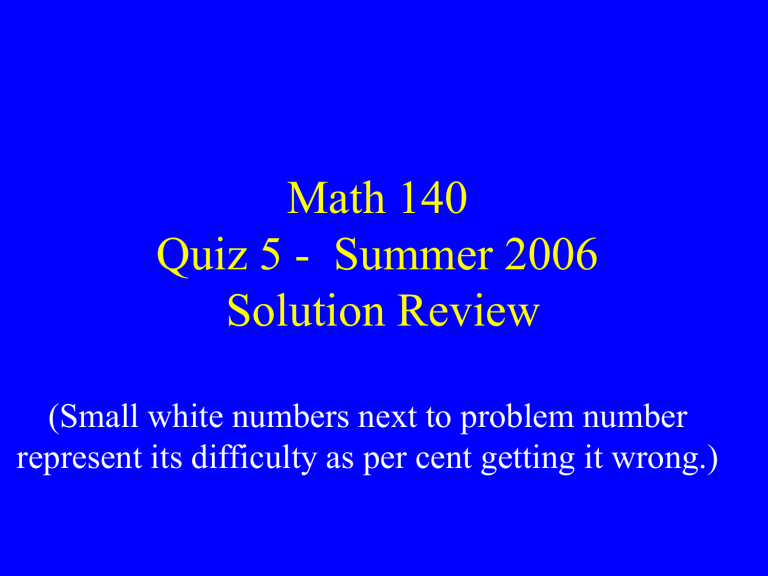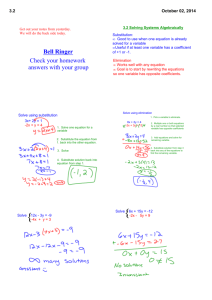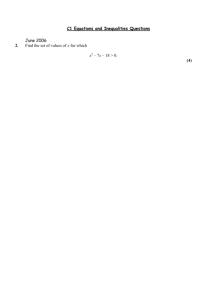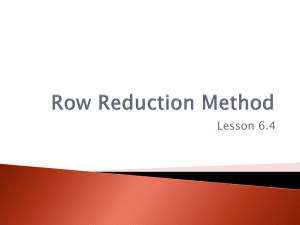Math 140 Quiz 5 Solutions

Math 140
Quiz 5 - Summer 2006
Solution Review
(Small white numbers next to problem number represent its difficulty as per cent getting it wrong.)
Problem 1
(05)
Solve the system. (7/3) x + (5/4) y = 4 (a)
(5/6) x 2 y = 21 (b)
Using the method of substitution, select an equation, say (b), to solve for a selected variable, say, y : y = (5/12) x - (21/2). (c)
Then, substitute this for y in (a) & solve for x :
(7/3) x + (5/4) [(5/12) x - (21/2)] = 4
Hence, x = (4+105/8)/[(7/3)+(5/4) (5/12)] = 6.
Put this in (c) to get: y = (5/12)(6) - (21/2) = -8. (6, -8)
Problem 2
(33)
Determine the number of solutions for the given system without solving the system.
4 x 3 y = 5 (a)
16 x - 12 y = 20 (b)
Replace (b) by (b) minus 4 times (a): 0 = 0.
This is indicates a consistent system with an infinite number of solutions.
Check by noting (b) is a line of same slope (4/3) and y -intercept (–5/3) as (a). Thus, it is the same line.
Problem 3
(33)
Determine the number of solutions for the given system without solving the system.
3 x + 3 y = -2 (a)
12 x + 12 y = 3 (b)
Replace (b) by: (b) minus 4 times (a) => 0 = 11 !!!
This is indicates an inconsistent system with no solution.
Note: (a) & (b) are lines of same slope (-4/3) but differing y -intercepts (2/3) & (-1/4). Thus, they are parallel lines and do not intersect.
Problem 4
(19)
Use a calculator to solve the system of equations.
y = 2.12
x - 31 (a) y = -0.7
x + 24 (b)
Substitute for y in (a) the y given in (b) & solve for x .
Then, from (b): y = -0.7(33.09153) + 24 = 0.83593
Problem 5
(43)
Solve: A twin-engine aircraft can fly 1190 miles from city A to city B in 5 hours with the wind and make the return trip in 7 hours against the wind.
What is the speed of the wind?
Let speeds be p for plane & w for wind. Then,
5( p + w ) = 1190 (a)
7( p w ) = 1190 (b)
After dividing (a) by 5 & (b) by 7, subtract them.
2 w = 238 – 170 = 68 w = 34 miles per hour
Problem 6
(24)
Solve the system of equations.
2
5
2 x x x
4
4 y y y
5 z z z
8
29
7
Use augmented matrix for system & manipulate to
row echelon form by row operations.
2
5
2
4
4
1
1
1
5
8
29
7
1
0
0
14
2
3
1
2
7
2
4
4
49
1
1
0
0
2
1
0
1
2
1
4
19
4
2
19
2
4
7
R
3
= -r
1
+ r
3
, R
1
= r
1
/2,
R
2
= -r
2
/14,
R
2
= -5r
1
+ r
2
R
3
= 3r
2
+ r
3
Problem 6 cont’d
(24)
Solve the system of equations.
2
5
2 x x x
4
4 y y y
5 z z z
8
29
7
Use augmented matrix for system & manipulate to
row echelon form by row operations.
1
0
0
2
1
0
1
2
1
4
1
7
2
4
2
y = -7/2 z z = -2
/4 = -7/2 - (-2)/4 = -3
R
3
= r
3
/(14/19) x = -4 z /2 - 2 y = -4 - (-2)/2 -2(-3) = 3
Problem 7
(0 !
)
Write the augmented matrix for the system.
8 x
3 x
4 x
2 y
7 y
2 y
2 z
7 z
3 z
28
9
13
The augmented matrix for the system is obtained by just copying the coefficients in the standard equations.
8
3
4
2
7
2
2
7
3
28
9
13
Problem 8
(0 !
)
Write a system of equations associated with the augmented matrix. Do not try to solve.
5
3
7
8
5
9
The standard equations are obtained from the augmented matrix for the system by just copying the coefficients into their places.
5 x
7 y
5
3 x
8 y
9
1
2
4
Problem 9
(29)
Perform in order (a), (b), and (c) on the augmented matrix. (a) R
2
= -2r
1
+ r
2
(b) R
3
= 4r
1
+ r
3
(c) R
3
= 3r
2
+ r
3
3
5
5
5
2
4
2
5
6
1
0
4
3
1
5
5
12
4
2
1
6
1
0
0
3
1
17
5
12
16
2
1
14
1
0
0
3
1
14
5
12
20
2
1
17
Problem 10
(19)
Find the value of the determinant.
3
7 b a
3 b
7
3 a
(
7 ) b
3 a
7 b a
Problem 11
(38)
Find the value of the determinant.
2
5
4
1
4
5
3 4 1
Use, e.g., (a) R
1
= r expand down column 2.
1
+ r
3
, (b) R
3
= -4r
2
+ r
3
, &
1
23
1
5
23
0
1
0
5
5
19
5
19
( 1 )(
19 )
( 5 )( 23 )
134
Problem 12
(81)
Use the properties of determinants to find the value of the second determinant, given the value of the first.
x y z 3 3
3
D
1
u
1 v
1 w
1
4 D
2
u x v y w z
?
Note the matrix in D
2
(a) a row swap R
1
= r
3 differs from that in
, R
3
= r
1
D
1 only by
; & (b) by the factor of
3 in row 1 of D
2
. In the R
1 row expansion of D
2 these yield a (-1) overall & an overall factor of 3 compared to the R
3 row expansion of D
1
. Details are on next slide. The result is D
2
= -3 D
1
= 12.
Problem 12 cont’d
(81)
Use the properties of determinants to find the value of the second determinant, given the value of the first.
x y z 3 3
3
D
1
u
1 v
1 w
1
4 D
2
u x v y w z
?
The R
1 row expansion of D
2 is: z z
3
v y w
z u x w z
u x v y
a c b d
3
c a y v d b z w
x x z w
x u
Since & above is D
1 y v
’s R
3 D
1
3
12 .
row expansion.
Problem 13
(05)
Use Cramer's rule to solve the linear system.
2.110
2.498
x 0.205
x 0.267
y
15.855
y
18.649
Construct & evaluate the determinants:
D
2.110
2.498
0.205
-0.05128
0.267
D x
15.855
18.649
0.205
0.267
-0.41024
D y
2.110
2.498
15.855
18.649
0 .
2564
Then, x = D x
/ D = -0.41024/(-.05128) = 8 y = D y
/ D = - 0.2564/(-.05128) = 5
Problem 14
(10)
Use Cramer's rule to solve the linear system.
2 x
4 x
x
2
y
2 y -
3 z
z
-
11 y
z
10
6
Construct & evaluate the determinants:
2 2
1 11 2
1
D
1
2 3
3 D x
6
2 3
3
4
2
D y
1
1
11
6
1
1
3
15
10
2
D z
1
1
2
2
1
11
6
3
4 10 1 4 1 10
Then, x = D x
______________
/ D = 3/3= 1, y = D y z = D z
/ D = 3/3= 1.
/ D = 15/3 = 5,
Problem 15
(10)
Solve the system. x 2 + y 2 = 100 (a) x + y = 2 (b)
Using the method of substitution, select an equation, preferably (b), to solve for a selected variable, say, y : y = x + 2. (c)
Then, substitute this for y in (a) & solve for x : x 2 + (x + 2) 2 = 100 => 2 x 2 –4 x
– 96 = 0.
Divide by 2 & factor: ( x -8)( x +6)=0 => x = 8 or -6.
Put this in (c): y = -6 or 8. => {(8, -6), (-6, 8)}
Problem 16
(10)
Solve the system. xy = 20 (a) x + y = 9 (b)
Using the method of substitution, select an equation, preferably (b), to solve for a selected variable, say, y : y = x + 9. (c)
Then, substitute this for y in (a) & solve for x : x (x + 9) = 20 => x 2 - 9 x + 20 = 0.
Factor: ( x
– 4)( x
– 5) = 0 => x = 4 or 5.
Put this in (c): y = 5 or 4. => {(4, 5), (5, 4)} See graph.
Problem 16 cont’d
(10)
Solve the system. xy = 20 (a) x + y = 9 (b)
Solution is: {(4, 5), (5, 4)}.
Graph of (a) & (b) Zoomed in
Problem 17
(10)
Solve the system. x 2 + y 2 = 25 (a) x 2 – y 2 = 25 (b)
Using the method of elimination, add & subtract the equations:
2 x 2 = 50 and 2 y 2 = 0.
Thus, solving this for x & y : x = +5 and y = 0.
{(-5, 0), (5, 0)}
Graph of (a) & (b)
Problem 18
(33)
Solve the system. 2 x 2 + y 2 = 66 (a) x 2 + y 2 = 41 (b)
Using the method of elimination, subtract the equations & back substitute result: x 2 = 25 and 25 + y 2 = 41.
Thus, solving this for x & y : x = +5 and y = + 4.
{(-5, 4), (5, 4), (-5, -4), (5, -4)}
Graph of (a) & (b)
Problem 19
(52)
Solve the system. x 2 xy + y 2 = 3 (a)
2 x 2 + xy + 2 y 2 = 12 (b)
Using the method of elimination, add the equations, simplify, & back substitute result: x 2 + y 2 = 5 and xy = 2.
Then, solving this for x & y : y = 2/ x => x 2 + (2/ x ) 2 = 5, x 4 - 5 x 2 + 4 = 0 => x 2 = 1 or 4.
{(-1, -2), (1, 2), (-2, -1), (2, 1)}
Graph of (a) & (b)
Problem 20
(33)
Solve: A rectangular piece of tin has area 736 in.
2 . A square of 3 in. is cut from each corner, and an open box is made by turning up the ends and sides. If the volume of the box is 1200 in.
3 , what were the original dimensions of the piece of tin?
Let sides of tin be h & w . Then,
3
3 h w
Tin area: hw = 736 (a)
Box volume: 3( h 6)( w 6) = 1200 (b)
Problem 20 cont’d
(29) hw = 736 (a)
3( h 6)( w 6) = 1200 (b)
After dividing (b) by 3 & expanding (b)’s product hw 6 w 6 h +36 = 400.
Simplifying this with use of (a) we replace (b) with: h + w = 62 (c)
Solve (c) for w = 62 h & substitute in (a), h (62 h ) = 736 => h 2 - 62 h +736 = ( h -16) ( h -46) =0
So h = 16 or 46 & w = 46 or 16. Tin is 16 in. by 46 in.





